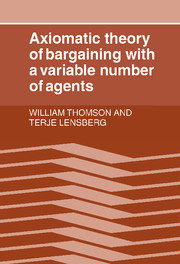Book contents
- Frontmatter
- Contents
- Acknowledgments
- List of symbols and notation
- List of axioms
- 1 Preliminaries
- 2 Axiomatic theory of bargaining with a fixed number of agents
- 3 Population Monotonicity and the Kalai–Smorodinsky solution
- 4 Population Monotonicity and the Egalitarian solution
- 5 Truncated Egalitarian and Monotone Path solutions
- 6 Guarantees and opportunities
- 7 Stability and the Nash solution
- 8 Stability without Pareto-Optimality
- 9 Stability and the Leximin solution
- 10 Population Monotonicity, Weak Stability, and the Egalitarian solution
- 11 Stability and Collectively Rational solutions
- 12 Invariance under Replication and Juxtaposition
- Bibliography
- Index
4 - Population Monotonicity and the Egalitarian solution
Published online by Cambridge University Press: 23 March 2010
- Frontmatter
- Contents
- Acknowledgments
- List of symbols and notation
- List of axioms
- 1 Preliminaries
- 2 Axiomatic theory of bargaining with a fixed number of agents
- 3 Population Monotonicity and the Kalai–Smorodinsky solution
- 4 Population Monotonicity and the Egalitarian solution
- 5 Truncated Egalitarian and Monotone Path solutions
- 6 Guarantees and opportunities
- 7 Stability and the Nash solution
- 8 Stability without Pareto-Optimality
- 9 Stability and the Leximin solution
- 10 Population Monotonicity, Weak Stability, and the Egalitarian solution
- 11 Stability and Collectively Rational solutions
- 12 Invariance under Replication and Juxtaposition
- Bibliography
- Index
Summary
Introduction
In this chapter we offer a characterization of the Egalitarian solution based on the axiom of Population Monotonicity introduced in Chapter 3 as well as on several familiar axioms. Specifically, we show that the Egalitarian solution is the only solution to satisfy Weak Pareto-Optimality, Symmetry, Independence of Irrelevant Alternatives, Continuity, and Population Monotonicity. This list of axioms differs from the list used in Chapter 3 to characterize the Kalai–Smorodinsky solution only in that the independence axiom replaces the invariance axiom. The independence axiom has already been briefly encountered in Chapter 2. The present chapter opens with its detailed evaluation.
First, recall that the independence axiom originally introduced by Nash (his property 7 on p. 159 in 1950, his axiom V on p. 137 in 1953) states that restricting a problem without eliminating the alternative chosen as best for that problem should leave this best alternative unaffected. Since there are fewer alternatives with which the originally chosen alternative is competing, this should strengthen its appeal. The axiom has been the object of a large amount of attention, and it has been adapted to a number of other contexts. In the social choice literature, it is now known under a variety of names, such as Property α, contraction consistency, and the Chernoff condition. [See, for instance, Sen (1979), who discusses it and relates it to similar axioms.] Here we will keep the phrase independence of irrelevant alternatives, which seems to have remained standard in bargaining theory (see Roth, 1979b), with a warning that the axiom should not be confused with the condition of the same name used by Arrow (1951).
- Type
- Chapter
- Information
- Publisher: Cambridge University PressPrint publication year: 1989



